Abstract
The plasma concentration of the atherogenic low density lipoproteins (LDL) increases with age. To clarify the mechanism of this change, we studied the kinetics of autologous 125I-LDL apolipoprotein B (apo B) in 41 normolipidemic, nonobese healthy males. For comparison, they were divided into three age groups: young, 21-39 yr (n = 18), middle-aged, 40-59 yr (n = 11), and old, 60-80 yr (n = 12). The levels of plasma LDL cholesterol and LDL apo B increased from respectively 3.4 +/- 0.1 (SEM) mmol/liter and 86 +/- 2 mg/dl in the young to 4.1 +/- 0.1 mmol/liter and 95 +/- 3 mg/dl in the old (P less than 0.01), and this increase was linked to a progressively decreased (r = -0.38, P less than 0.02) fractional catabolic rate of LDL apo B (0.348 +/- 0.010 pools per day in the young vs. 0.296 +/- 0.009 pools per day in the old, P less than 0.01). The production rate of LDL apo B did not differ significantly between the groups. The reduced fractional catabolic rate of LDL apo B in the old was not associated with a decrease in binding affinity of the LDL particle to its receptor, as judged from its ability to compete for 125I-LDL fibroblast binding. When hepatic LDL receptor expression was stimulated by cholestyramine treatment in six old males, their LDL apo B fractional catabolic rate increased to the levels observed in the young subjects. We conclude that the increase in LDL which normally occurs with age is explained by a reduced capacity for its removal, and hypothesize that this is mediated via a reduced hepatic LDL receptor expression.
Full text
PDF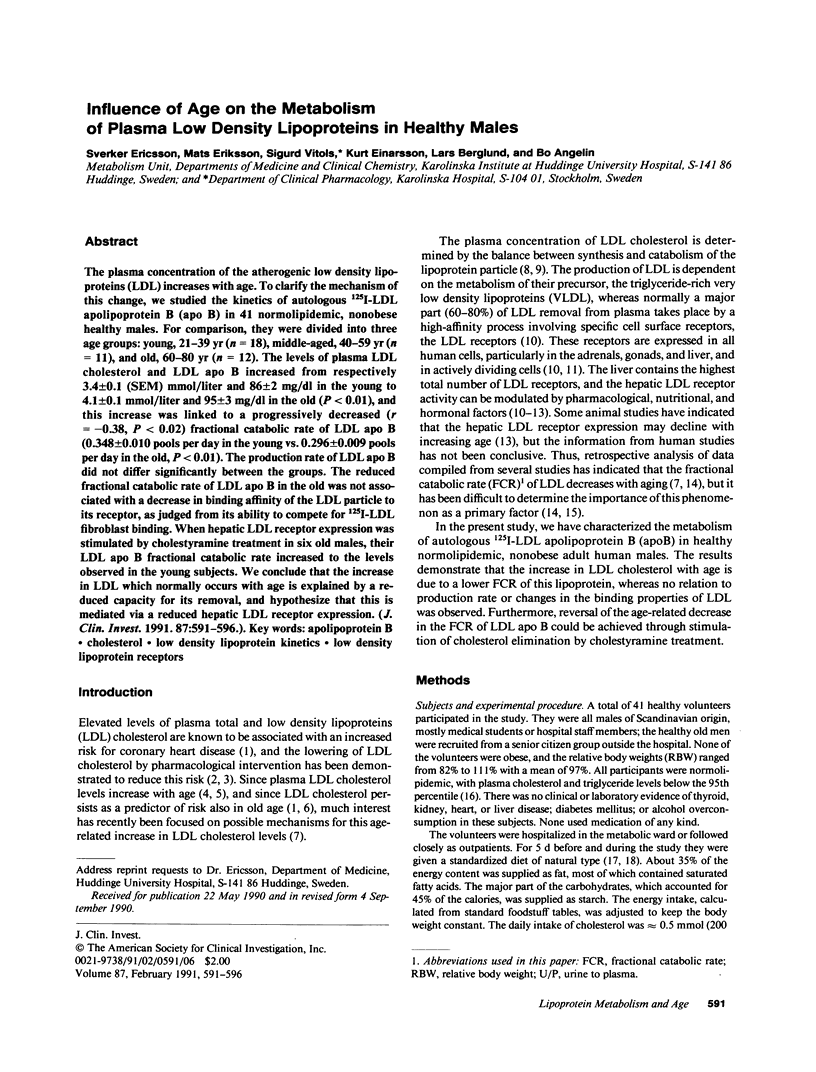
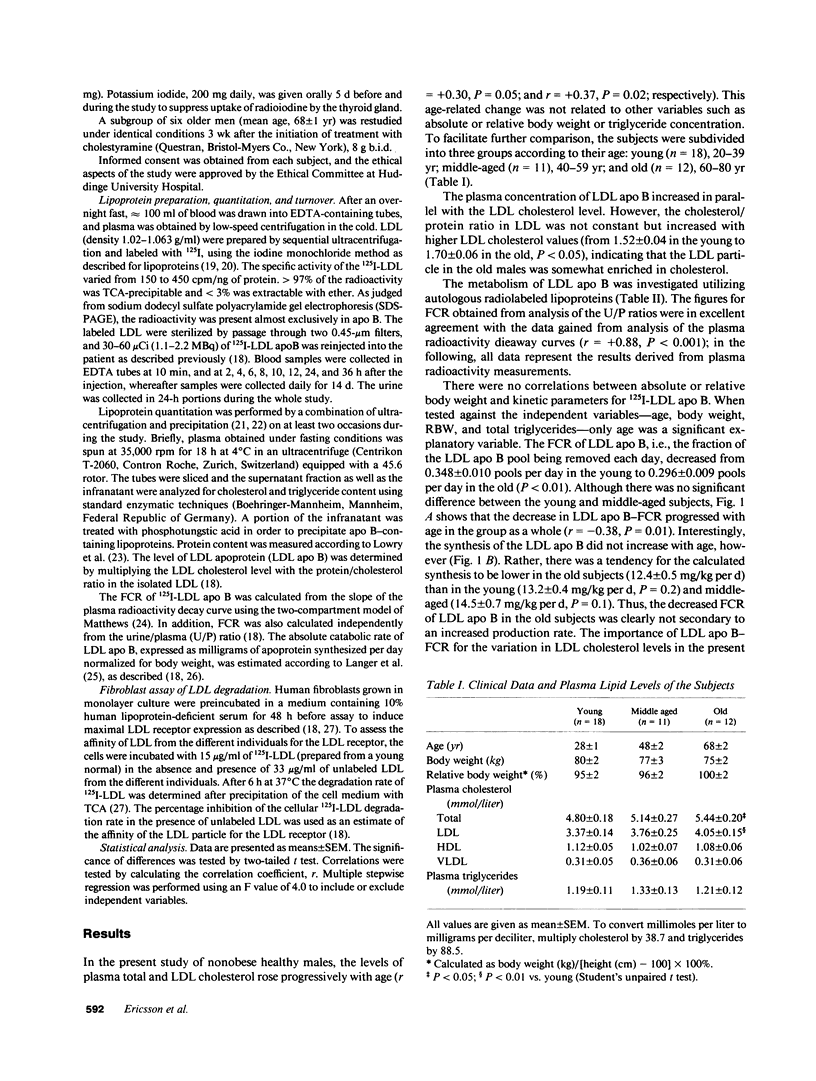
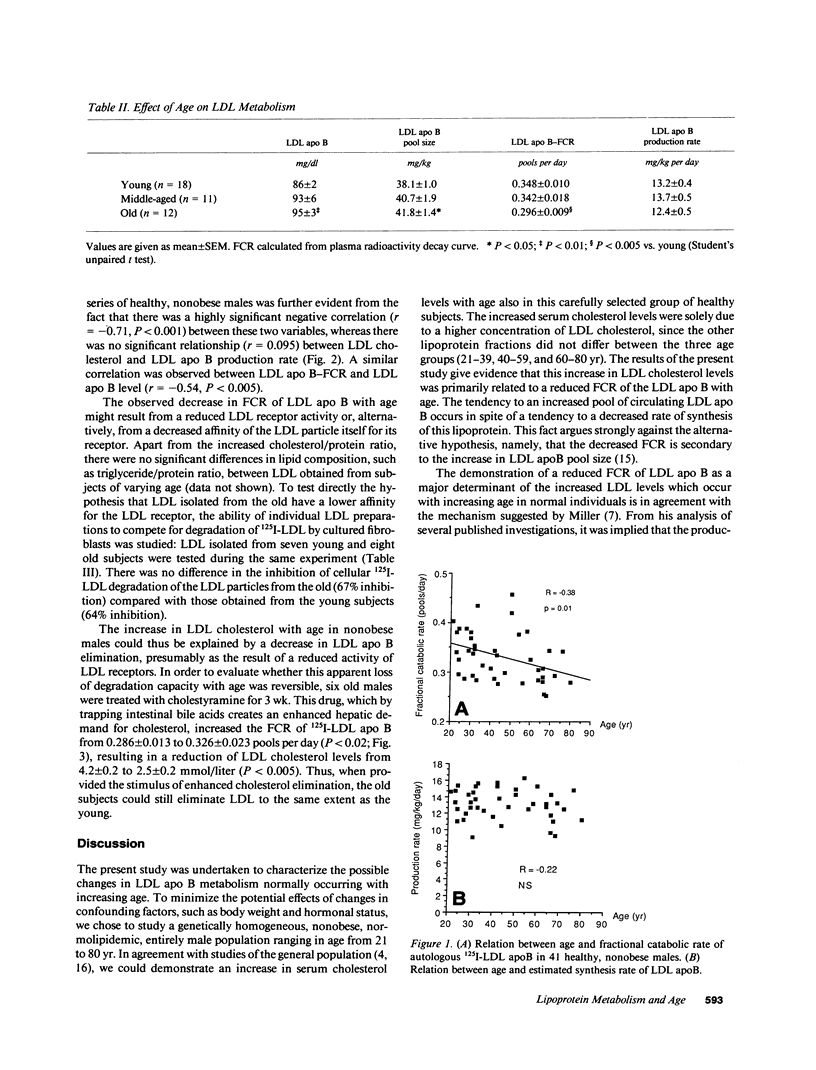
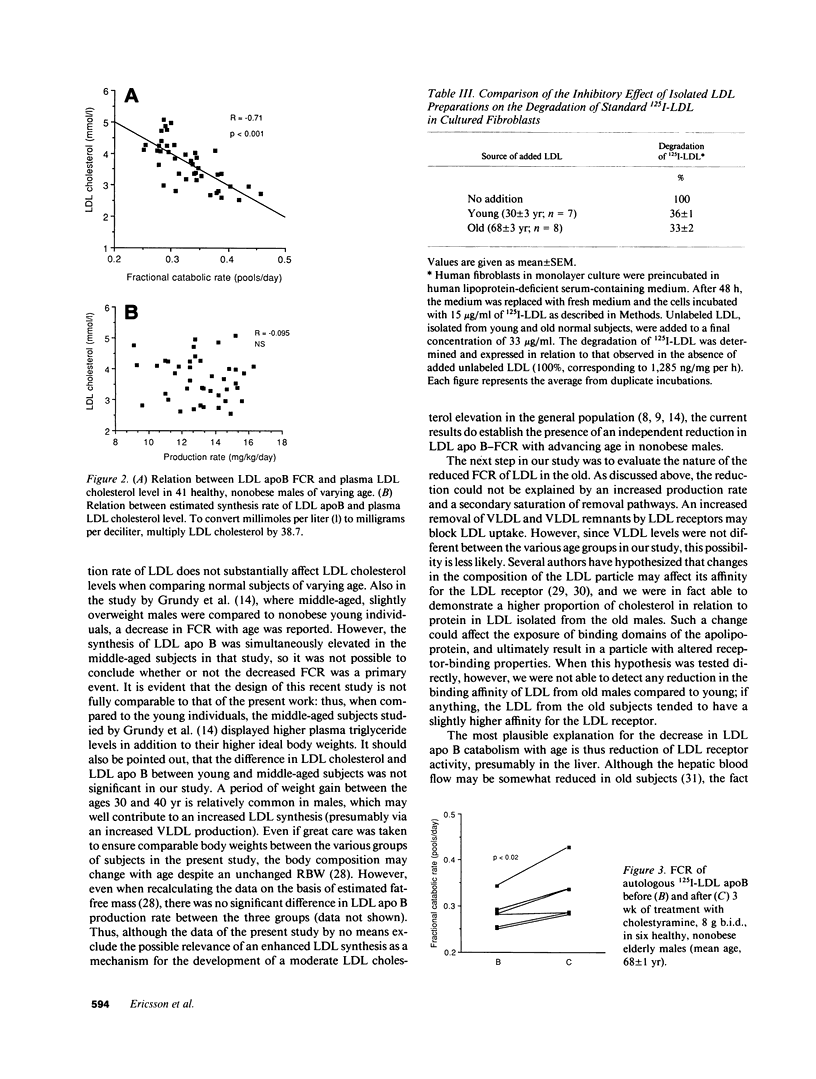
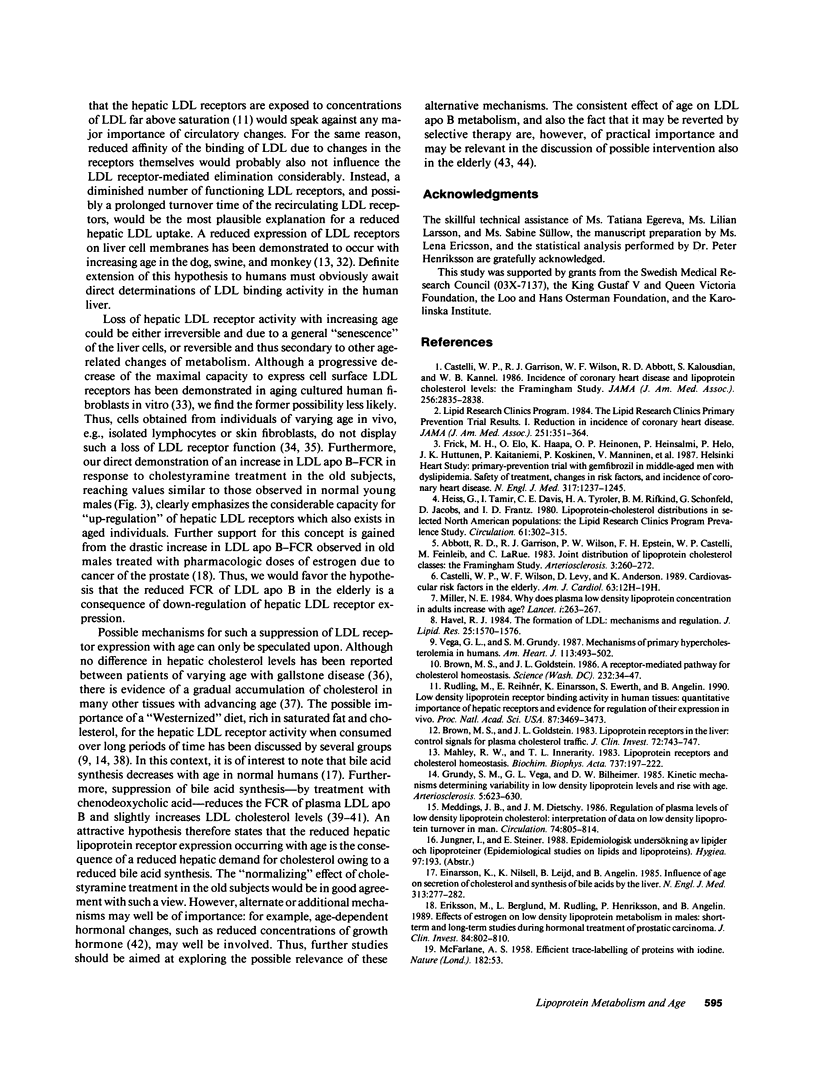
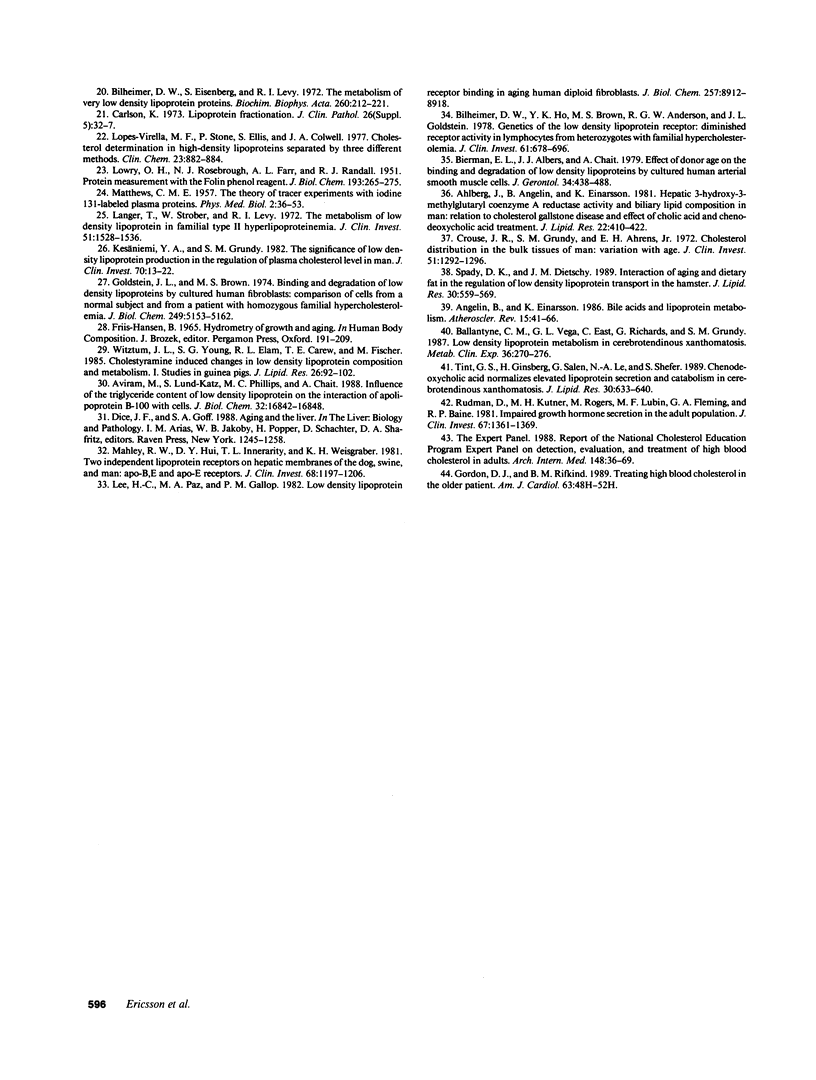
Selected References
These references are in PubMed. This may not be the complete list of references from this article.
- Abbott R. D., Garrison R. J., Wilson P. W., Epstein F. H., Castelli W. P., Feinleib M., LaRue C. Joint distribution of lipoprotein cholesterol classes. The Framingham study. Arteriosclerosis. 1983 May-Jun;3(3):260–272. doi: 10.1161/01.atv.3.3.260. [DOI] [PubMed] [Google Scholar]
- Ahlberg J., Angelin B., Einarsson K. Hepatic 3-hydroxy-3-methylglutaryl coenzyme A reductase activity and biliary lipid composition in man: relation to cholesterol gallstone disease and effects of cholic acid and chenodeoxycholic acid treatment. J Lipid Res. 1981 Mar;22(3):410–422. [PubMed] [Google Scholar]
- Aviram M., Lund-Katz S., Phillips M. C., Chait A. The influence of the triglyceride content of low density lipoprotein on the interaction of apolipoprotein B-100 with cells. J Biol Chem. 1988 Nov 15;263(32):16842–16848. [PubMed] [Google Scholar]
- Ballantyne C. M., Vega G. L., East C., Richards G., Grundy S. M. Low-density lipoprotein metabolism in cerebrotendinous xanthomatosis. Metabolism. 1987 Mar;36(3):270–276. doi: 10.1016/0026-0495(87)90187-9. [DOI] [PubMed] [Google Scholar]
- Bierman E. L., Albers J. J., Chait A. Effect of donor age on the binding and degradation of low density lipoproteins by cultured human arterial smooth muscle cells. J Gerontol. 1979 Jul;34(4):483–488. doi: 10.1093/geronj/34.4.483. [DOI] [PubMed] [Google Scholar]
- Bilheimer D. W., Eisenberg S., Levy R. I. The metabolism of very low density lipoprotein proteins. I. Preliminary in vitro and in vivo observations. Biochim Biophys Acta. 1972 Feb 21;260(2):212–221. doi: 10.1016/0005-2760(72)90034-3. [DOI] [PubMed] [Google Scholar]
- Bilheimer D. W., Ho Y. K., Brown M. S., Anderson R. G., Goldstein J. L. Genetics of the low density lipoprotein receptor. Diminished receptor activity in lymphocytes from heterozygotes with familial hypercholesterolemia. J Clin Invest. 1978 Mar;61(3):678–696. doi: 10.1172/JCI108980. [DOI] [PMC free article] [PubMed] [Google Scholar]
- Brown M. S., Goldstein J. L. A receptor-mediated pathway for cholesterol homeostasis. Science. 1986 Apr 4;232(4746):34–47. doi: 10.1126/science.3513311. [DOI] [PubMed] [Google Scholar]
- Brown M. S., Goldstein J. L. Lipoprotein receptors in the liver. Control signals for plasma cholesterol traffic. J Clin Invest. 1983 Sep;72(3):743–747. doi: 10.1172/JCI111044. [DOI] [PMC free article] [PubMed] [Google Scholar]
- Carlson K. Lipoprotein fractionation. J Clin Pathol Suppl (Assoc Clin Pathol) 1973;5:32–37. doi: 10.1136/jcp.s1-5.1.32. [DOI] [PMC free article] [PubMed] [Google Scholar]
- Castelli W. P., Garrison R. J., Wilson P. W., Abbott R. D., Kalousdian S., Kannel W. B. Incidence of coronary heart disease and lipoprotein cholesterol levels. The Framingham Study. JAMA. 1986 Nov 28;256(20):2835–2838. [PubMed] [Google Scholar]
- Crouse J. R., Grundy S. M., Ahrens E. H., Jr Cholesterol distribution in the bulk tissues of man: variation with age. J Clin Invest. 1972 May;51(5):1292–1296. doi: 10.1172/JCI106924. [DOI] [PMC free article] [PubMed] [Google Scholar]
- Einarsson K., Nilsell K., Leijd B., Angelin B. Influence of age on secretion of cholesterol and synthesis of bile acids by the liver. N Engl J Med. 1985 Aug 1;313(5):277–282. doi: 10.1056/NEJM198508013130501. [DOI] [PubMed] [Google Scholar]
- Eriksson M., Berglund L., Rudling M., Henriksson P., Angelin B. Effects of estrogen on low density lipoprotein metabolism in males. Short-term and long-term studies during hormonal treatment of prostatic carcinoma. J Clin Invest. 1989 Sep;84(3):802–810. doi: 10.1172/JCI114239. [DOI] [PMC free article] [PubMed] [Google Scholar]
- Frick M. H., Elo O., Haapa K., Heinonen O. P., Heinsalmi P., Helo P., Huttunen J. K., Kaitaniemi P., Koskinen P., Manninen V. Helsinki Heart Study: primary-prevention trial with gemfibrozil in middle-aged men with dyslipidemia. Safety of treatment, changes in risk factors, and incidence of coronary heart disease. N Engl J Med. 1987 Nov 12;317(20):1237–1245. doi: 10.1056/NEJM198711123172001. [DOI] [PubMed] [Google Scholar]
- Goldstein J. L., Brown M. S. Binding and degradation of low density lipoproteins by cultured human fibroblasts. Comparison of cells from a normal subject and from a patient with homozygous familial hypercholesterolemia. J Biol Chem. 1974 Aug 25;249(16):5153–5162. [PubMed] [Google Scholar]
- Gordon D. J., Rifkind B. M. Treating high blood cholesterol in the older patient. Am J Cardiol. 1989 May 2;63(16):48H–52H. doi: 10.1016/0002-9149(89)90116-1. [DOI] [PubMed] [Google Scholar]
- Grundy S. M., Vega G. L., Bilheimer D. W. Kinetic mechanisms determining variability in low density lipoprotein levels and rise with age. Arteriosclerosis. 1985 Nov-Dec;5(6):623–630. doi: 10.1161/01.atv.5.6.623. [DOI] [PubMed] [Google Scholar]
- Havel R. J. The formation of LDL: mechanisms and regulation. J Lipid Res. 1984 Dec 15;25(13):1570–1576. [PubMed] [Google Scholar]
- Heiss G., Tamir I., Davis C. E., Tyroler H. A., Rifkand B. M., Schonfeld G., Jacobs D., Frantz I. D., Jr Lipoprotein-cholesterol distributions in selected North American populations: the lipid research clinics program prevalence study. Circulation. 1980 Feb;61(2):302–315. doi: 10.1161/01.cir.61.2.302. [DOI] [PubMed] [Google Scholar]
- Kesaniemi Y. A., Grundy S. M. Significance of low density lipoprotein production in the regulations of plasma cholesterol level in man. J Clin Invest. 1982 Jul;70(1):13–22. doi: 10.1172/JCI110585. [DOI] [PMC free article] [PubMed] [Google Scholar]
- LOWRY O. H., ROSEBROUGH N. J., FARR A. L., RANDALL R. J. Protein measurement with the Folin phenol reagent. J Biol Chem. 1951 Nov;193(1):265–275. [PubMed] [Google Scholar]
- Langer T., Strober W., Levy R. I. The metabolism of low density lipoprotein in familial type II hyperlipoproteinemia. J Clin Invest. 1972 Jun;51(6):1528–1536. doi: 10.1172/JCI106949. [DOI] [PMC free article] [PubMed] [Google Scholar]
- Lee H. C., Paz M. A., Gallop P. M. Low density lipoprotein receptor binding in aging human diploid fibroblasts in culture. J Biol Chem. 1982 Aug 10;257(15):8912–8918. [PubMed] [Google Scholar]
- Lopes-Virella M. F., Stone P., Ellis S., Colwell J. A. Cholesterol determination in high-density lipoproteins separated by three different methods. Clin Chem. 1977 May;23(5):882–884. [PubMed] [Google Scholar]
- MATTHEWS C. M. The theory of tracer experiments with 131I-labelled plasma proteins. Phys Med Biol. 1957 Jul;2(1):36–53. doi: 10.1088/0031-9155/2/1/305. [DOI] [PubMed] [Google Scholar]
- Mahley R. W., Hui D. Y., Innerarity T. L., Weisgraber K. H. Two independent lipoprotein receptors on hepatic membranes of dog, swine, and man. Apo-B,E and apo-E receptors. J Clin Invest. 1981 Nov;68(5):1197–1206. doi: 10.1172/JCI110365. [DOI] [PMC free article] [PubMed] [Google Scholar]
- Mahley R. W., Innerarity T. L. Lipoprotein receptors and cholesterol homeostasis. Biochim Biophys Acta. 1983 May 24;737(2):197–222. doi: 10.1016/0304-4157(83)90001-1. [DOI] [PubMed] [Google Scholar]
- Meddings J. B., Dietschy J. M. Regulation of plasma levels of low-density lipoprotein cholesterol: interpretation of data on low-density lipoprotein turnover in man. Circulation. 1986 Oct;74(4):805–814. doi: 10.1161/01.cir.74.4.805. [DOI] [PubMed] [Google Scholar]
- Miller N. E. Why does plasma low density lipoprotein concentration in adults increase with age? Lancet. 1984 Feb 4;1(8371):263–267. doi: 10.1016/s0140-6736(84)90135-1. [DOI] [PubMed] [Google Scholar]
- Rudling M. J., Reihnér E., Einarsson K., Ewerth S., Angelin B. Low density lipoprotein receptor-binding activity in human tissues: quantitative importance of hepatic receptors and evidence for regulation of their expression in vivo. Proc Natl Acad Sci U S A. 1990 May;87(9):3469–3473. doi: 10.1073/pnas.87.9.3469. [DOI] [PMC free article] [PubMed] [Google Scholar]
- Rudman D., Kutner M. H., Rogers C. M., Lubin M. F., Fleming G. A., Bain R. P. Impaired growth hormone secretion in the adult population: relation to age and adiposity. J Clin Invest. 1981 May;67(5):1361–1369. doi: 10.1172/JCI110164. [DOI] [PMC free article] [PubMed] [Google Scholar]
- Spady D. K., Dietschy J. M. Interaction of aging and dietary fat in the regulation of low density lipoprotein transport in the hamster. J Lipid Res. 1989 Apr;30(4):559–569. [PubMed] [Google Scholar]
- Tint G. S., Ginsberg H., Salen G., Le N. A., Shefer S. Chenodeoxycholic acid normalizes elevated lipoprotein secretion and catabolism in cerebrotendinous xanthomatosis. J Lipid Res. 1989 May;30(5):633–640. [PubMed] [Google Scholar]
- Vega G. L., Grundy S. M. Mechanisms of primary hypercholesterolemia in humans. Am Heart J. 1987 Feb;113(2 Pt 2):493–502. doi: 10.1016/0002-8703(87)90620-x. [DOI] [PubMed] [Google Scholar]
- Witztum J. L., Young S. G., Elam R. L., Carew T. E., Fisher M. Cholestyramine-induced changes in low density lipoprotein composition and metabolism. I. Studies in the guinea pig. J Lipid Res. 1985 Jan;26(1):92–103. [PubMed] [Google Scholar]


